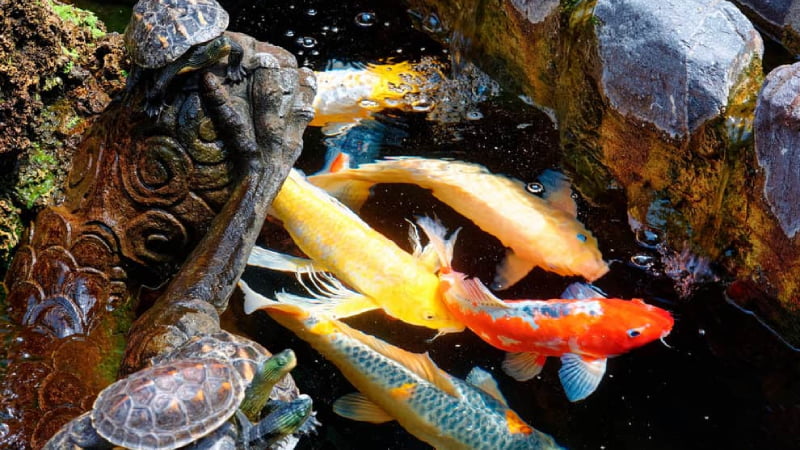Koi fish are among the most popular types of pond fish, and they may be found in a variety of sizes and colors. They are stunningly gorgeous, vibrantly colored, and very serene. Although if you have ever had koi as a pet, you are likely to be familiar with how untidy they can be! What about turtles, on the other hand? Is it possible for them to coexist in a pond, or will turtles eat koi fish? Let’s have a look and see!
Will Turtles Eat Koi Fish?
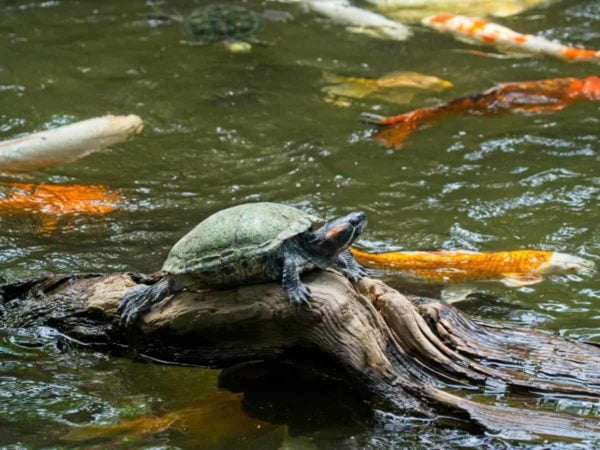
To maintain turtles and koi fish in the same pond, you must first solve the conundrum of an age-old question, which is why we have this guide. In this story, the turtles prey on the koi fish. Therefore, the danger of losing your favorite and most valuable koi is always present while keeping the two species together.
Nevertheless, it has not been shown that turtles would consume koi fish on a consistent basis. In actuality, it is dependent on a variety of factors. It occurs as a result of the fact that both turtles and koi fish are recognized for having an omnivorous diet. As a result, their dietary needs are quite similar.
There is a good probability that if you have a starving turtle in your pond, it will feast on anything it can find, even the koi. Furthermore, some turtles are voracious hunters, and these individuals are not hesitant to take on even the largest fish species. Baby snapping turtles, for example, are well-known for their voracious appetites and aggressive hunting behavior. As a result, when you maintain a hunter turtle with a koi, it is possible that the fish may be injured.
However, not all of the news is negative. Experts have said that if you provide enough food for both the turtle and the koi, they will live peacefully in the same pond. Yet, you will need to take a few things into consideration and prepare the pond in particular (I will give you the detailed information in the below part).
Some Factors Affect Turtles Eat Koi Fish
The likelihood that turtles may mistake your koi for food and attack depends on a number of factors. Some of these factors include the turtle’s size in relation to your koi fish’s size, the kind of turtle that it is, and how much food it gets.
Size and breed
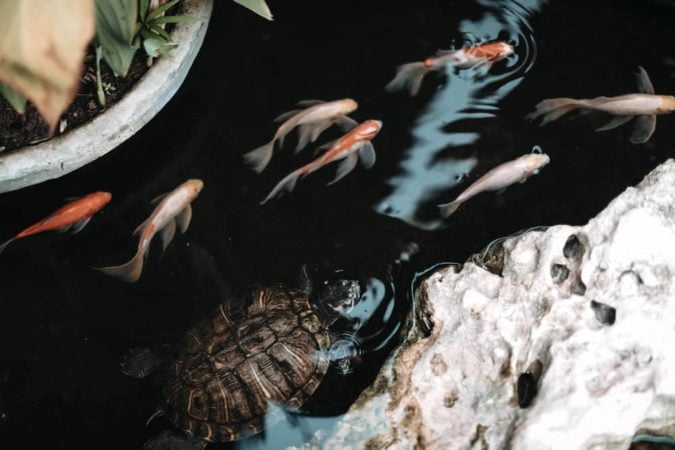
For obvious reasons, a 4-inch turtle will not have the ability to consume, much less hurt, a 24-inch koi fish. Small yearling koi, on the other hand, may be mistaken for food by giant adult tortoises if they are placed in a pond alongside large adult tortoises. The good news is that koi are renowned for developing to enormous sizes. Because of this, it is best to keep young, tiny turtles in a tank with big, adult koi.
This is not a basic rule, however, since the breed of turtle has a significant impact. Despite their size, a little snapping turtle may mistake a much bigger koi for food and attempt to eat them. Other, less aggressive turtles may never consider koi to be food, regardless of the size disparity between them. This is why it’s important to choose turtle breeds that aren’t too aggressive when adding them to your koi pond.
Before adding turtles to your collection, it is critical that you do a thorough study on the breeds. Turtles that are sold in pet shops have the potential to spread invasive species if your koi fish escape. Please keep in mind that they will be in an outdoor koi pond and that they will most likely be able to escape from inside the pond’s borders.
Turtles aren’t fed well
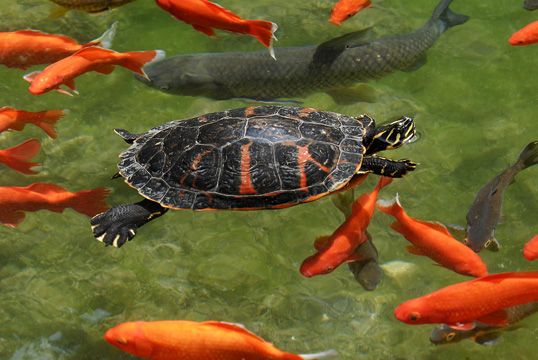
Interestingly, there is a significant overlap in the diets of turtles and koi. Therefore, keeping them nourished will not be a major concern, yet it is something that should be considered.
If a turtle isn’t given enough food, it will start to search for food in other places. This implies that if it grows to a big enough size, it may decide to take a nibble out of one of your fish. Alternatively, it may just migrate away from the pond in search of better pastures.
To ensure that the turtles are properly fed, the food may be put in a tiny plastic dish that is out of reach of the koi. After a while, the turtles will come to identify this feeding dish with food, making it simpler to keep track of how much they are eating.
Turtles in Koi Ponds: Special Considerations
If you don’t want to put your koi fish at danger of being eaten by a turtle, you’ll have to follow a few rules in order to keep them together in the same pond. These key elements are
- It’s essential to note that turtles are omnivorous in their diet. Some turtles prefer to subsist on meat, while others prefer to subsist on veggies. When keeping turtles with koi, look for varieties that like to consume solely vegetables and tiny insects rather than larger insects. It will no longer pose a hazard to the koi fish.
- In addition, if you plan on getting a native turtle species, verify the local restrictions. Native turtles cannot be kept in captivity without appropriate documentation and regulation in several states.
- When turtles are introduced into a koi pond, you must ensure that the water quality is maintained. Turtles are notoriously messy creatures. Aside from defecating heavily, turtles often drop bones and tails in the pond water. And pollution of the pond water has an effect on the health of the koi. So, if you do want to bring turtles to the koi pond, be prepared to control the water appropriately.
The Best Turtles To Keep In A Koi Pond
A native turtle may not always be the ideal option when it comes to finding the perfect turtle for a koi tank. As a result, we’ve spoken with both turtle and koi owners and selected 3 turtles that can live peacefully with the fish.
Spotted Turtles
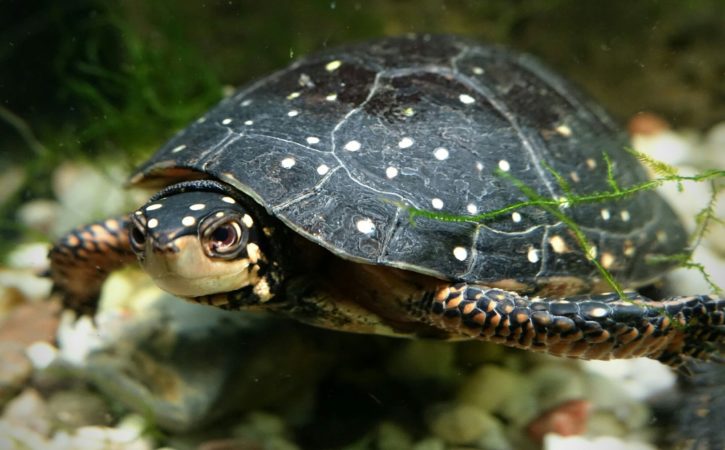
Spotted turtles are smaller in size than other turtles. You may expect them to reach a maximum height of 3.5 inches to 4.5 inches at the most. Their tiny size is an undeniable evidence that they are unable to consume koi fish. Spotted turtles are easily distinguished by their distinctive yellow dots on their black bodies. They mostly subsist on crickets and worms. The turtles are renowned for their gentle nature, and they will not be optimistic about their prospects against the koi fish.
Eastern Box Turtles
Eastern box turtles are available in a variety of sizes ranging from 4 inches to 6.5 inches in length. As a result, they are referred to as medium-sized turtles, and they are excellent companions for koi fish. Their shell has a high, circular form that resembles a dome in appearance. In addition, the shell features yellow to orange markings that make them clearly distinguishable from one another. In addition, the fact that eastern box turtles eat mostly vegetarian foods is one of their most ideal characteristics.
Painted Turtles
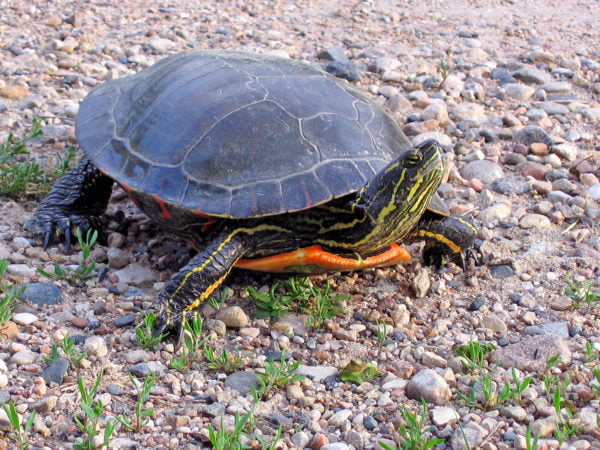
Even in a more relaxed setting, painted turtles may thrive. Aside from that, they’re a lovely addition to any pond. In the pond, this kind of turtle is peaceful and will not harm the koi fish. As a result, they’re ideal for taking on the role of turtle owner.
The painted turtles are between 8 and 12 inches in length. Therefore, maintaining these turtles alongside koi might provide a challenge due to their size. Nevertheless, they may live peacefully with the koi fish since they don’t prefer to rule the roosts.
Tips On Preparing Ponds For Koi And Turtles
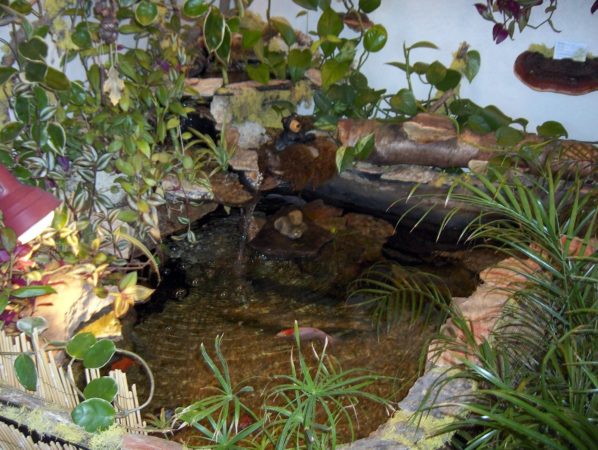
When you wish to raise koi and turtles in the same pond at the same time, you’ll need to take some extra precautions to make their home as comfortable as possible. The pond’s surface area must be large enough to allow for adequate oxygenation while maintaining a low oxygen concentration.
- Basking area: Keeping a brick, log, or other raised object surrounding the pond will allow the turtle to sunbathe in the sun. If you are able to submerge the turtle’s basking place just a little bit, it will be of tremendous assistance to the turtle. Once there, it will have an easier time getting to the basking area.
- Maintain an open area: Although your koi will not come out of the water, the turtle will most certainly do so. – As a result, make sure there is some open area surrounding the pond. Allowing the turtle to wander about the land surface will lessen the likelihood of the turtle being involved in a conflict with the koi, which will benefit both parties.
- Quality filtration: Whereas turtles tend to be messier than most other animals, koi fish like to live in a tidy and orderly habitat. Therefore, you must make certain that the pond is equipped with the highest-quality and most effective filtration equipment. Ensure that the filtration system is appropriate for the pond’s size. To guarantee the best quality and service, always purchase filters from the most reputable companies.
- Keep the pond from overpopulation: The koi fish is a big fish. As a result, they need enough area in the pond to be able to wander about freely. When you bring koi fish to a pond containing turtles, the area in the pond gets congested. Thus, maintaining a healthy balance in the quantity of koi fish and turtles is recommended. You must ensure that both species have adequate area in the pond to survive. This will lessen the likelihood of these species coming into contact with one another inside the pond.
- Provide a varied diet: Turtles and koi share a quite similar diet. Koi feed on a variety of foods ranging from microscopic worms to insects and beetles. Turtles, in a similar vein, consume both veggies and meat. So all that is required of you is to provide these species with the appropriate nutrition. Additionally, you can sometimes look for commercial koi and turtle food pellets to feed your fish and turtles. And, feeding your koi once a day is adequate for them. Furthermore, if feasible, place a plastic container outside the pond to serve as a feeding container for the turtle. It will rapidly come to identify the box with the act of consuming food. It will assist you in keeping the pond cleaner for a longer length of time.
Video: Turtles Eat Koi
FAQs
Is it possible to keep turtles in a koi pond?
Turtles do far better in a pond than they do in a tank of water. Yes, they will live well together with smaller koi if they are kept in the same pond.
Maintain the appropriate water parameters and temperatures in your pond, as well as any flora or plants in it. It is also important to consider the size of your koi, since turtles are known to prey on koi that are smaller in size than themselves.
Will turtles eat koi fish?
You have to be aware that if your turtles are bigger than your koi, then they will eat them. The reason for this is that turtles are omnivores and therefore will prey upon koi for their own food. Even so, adult koi can grow to be up to 12 inches long, so they are much more protected than young ones.
However, the key point is that turtles have to capture the koi fish first.
Koi are sluggish swimmers, yet they are nimble enough to avoid being eaten by turtles in a pond. But please note that turtles are four times quicker in water than they are on land, so your koi may still become the victim of a turtle attack.
Is it a good idea to keep turtles in your koi pond?
Koi ponds may be filled with almost any aquatic species that you like, so long as they are not poisonous. Some animals, such as turtles and frogs, even enhance the attractiveness of the fish by swimming beside them. Turtles are also important to the general health of a koi pond’s population of fish. They are preventing the algae from reproducing. Turtles also eat zooplankton, which is a minor food source for the koi that they consume.

Annette M. Chaney is an experienced marine biologist with over 20 years of experience as an aquarist and fishkeeper. She started her first aquarium at a young age, filling it with frogs and goldfish obtained from the ten-cent pet store.
Annette grew up caring for and breeding African Cichlids, which led to a hobby in high school that doubled as a profitable means. Attending Reed College gave her time to solidify herself as an accomplished aquarium caretaker with an eye for sales. After that, from 2009 – 2013, she studied at Roger Williams University – one of the most prestigious universities for Aquaculture and Aquarium in USA. She is the founder of AquariumCircle since 2010.
